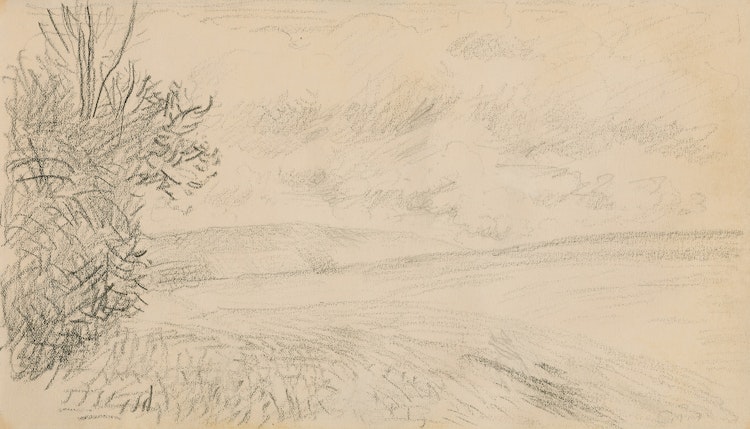Landscape by Camille Pissarro

Camille Pissarro
Landscape
pencil on paper
signed with initials lower right
5.25 x 9 in ( 13.3 x 22.9 cm ) ( sheet )
Auction Estimate: $15,000.00 - $20,000.00
Price Realized $13,200.00
Sale date: November 27th 2024
Provenance:
Doyle, auction, New York, 4 May 2011, lot 62
Estate of Robert Noakes
Doyle, auction, New York, 4 May 2011, lot 62
Estate of Robert Noakes
Exhibited:
"Pissarro Exhibition", Schoneman Galleries Inc., New York, 1959, no. 8627
"Pissarro Exhibition", Schoneman Galleries Inc., New York, 1959, no. 8627
Literature:
Terence Maloon, "Camille Pissarro", Sydney, 2005, page 18
Terence Maloon, "Camille Pissarro", Sydney, 2005, page 18
At the age of twenty-five, Camille Pissarro settled in Paris after leaving the Caribbean island of Saint Thomas, where he was born. There, he met Claude Monet and Paul Cézanne at the Atelier Suisse, a walk-in studio school. Cézanne and Pissarro would develop a close relationship, painting together en plein air in villages on the outskirts of Paris.
There is a certain level of sensitivity in Pissarro’s works that is apparent in his meticulous inspection and interpretation of clouds, trees, foliage, buildings, and light, but also in his rendition of workers, peasants and crowds. For him, the natural environment and human condition are equally worthy of attention. In the present work, a simple landscape has been rendered in quick, short pencil strokes, the cross-hatching especially visible in the foreground to depict dense vegetation.
The scene opens up onto an open field, with a mound rising in the background underneath a cloudy sky. Pissarro followed in the footsteps of Jean-Baptiste-Camille Corot, who could imbue a mundane motif with the most skilled artistic qualities. In his late 60s, he would reminisce on his awe at seeing one of Corot’s works in person at the Universal Exhibition of 1855: “One can make such beautiful things with so little... Old Corot made lovely things at Gisors: two willows, a bit of water, a bridge—like the picture in the Universal Exhibition, what a masterpiece! Happy are those who see beautiful things in modest places, where others see nothing. Everything is beautiful, the whole thing is knowing how to interpret.”
We are grateful to Dr. Joachim Pissarro and Alma Egger for confirming the authenticity of this work. The work will be included in the forthcoming catalogue raisonné of drawings and watercolours by Camille Pissarro.
There is a certain level of sensitivity in Pissarro’s works that is apparent in his meticulous inspection and interpretation of clouds, trees, foliage, buildings, and light, but also in his rendition of workers, peasants and crowds. For him, the natural environment and human condition are equally worthy of attention. In the present work, a simple landscape has been rendered in quick, short pencil strokes, the cross-hatching especially visible in the foreground to depict dense vegetation.
The scene opens up onto an open field, with a mound rising in the background underneath a cloudy sky. Pissarro followed in the footsteps of Jean-Baptiste-Camille Corot, who could imbue a mundane motif with the most skilled artistic qualities. In his late 60s, he would reminisce on his awe at seeing one of Corot’s works in person at the Universal Exhibition of 1855: “One can make such beautiful things with so little... Old Corot made lovely things at Gisors: two willows, a bit of water, a bridge—like the picture in the Universal Exhibition, what a masterpiece! Happy are those who see beautiful things in modest places, where others see nothing. Everything is beautiful, the whole thing is knowing how to interpret.”
We are grateful to Dr. Joachim Pissarro and Alma Egger for confirming the authenticity of this work. The work will be included in the forthcoming catalogue raisonné of drawings and watercolours by Camille Pissarro.
Share this item with your friends

